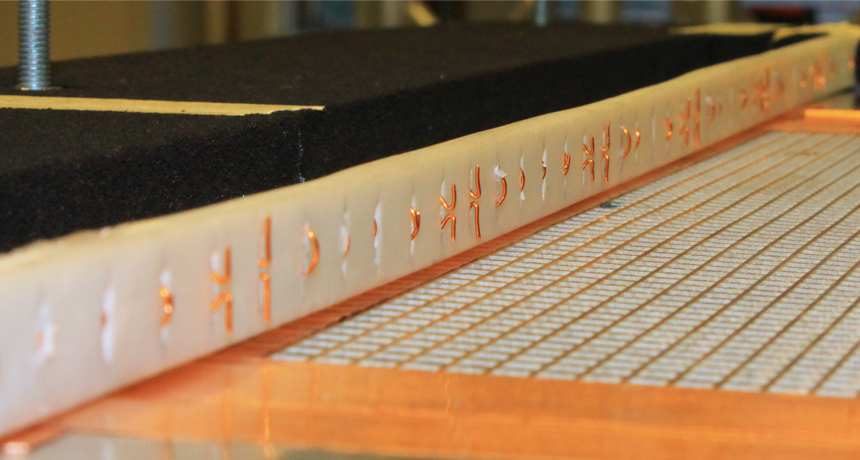New mirror picky in what it reflects
Some ‘light’ bounces off, most passes right through

A mirror made of copper wire embedded in plastic (left) reflects microwaves with a wavelength of about 60 millimeters. Other light treats it like a window and passes right through.
V.S. ASADCHY ET AL/PHYSICAL REVIEW LETTERS 2015
By Andrew Grant
Mirrors need not give you the full picture.
A new type of mirror can pick and choose what to reflect. For instance, it can selectively reflect a single wavelength of light. All others pass right through — as if the mirror was transparent. Such technology could be used to create more efficient satellite antennas.
Details appeared March 6 in the journal Physical Review Letters.
The mirror is constructed from metamaterials. These synthetic substances are made from elements that manipulate certain wavelengths of light.
Energy travels throughout the universe at the speed of light. It does so in the form of electromagnetic radiation. What that radiation is called depends on its wavelength, or color.A typical mirror contains a silvery layer. It reflects many types of radiation, including visible light. The new metamirror looks very different, explains Viktar Asadchy. A physicist, he works at Aalto University in Finland. The novel mirror he created consists of millimeter-sized loops of copper wire embedded in plastic.
His team beamed microwaves with a 60-millimeter wavelength at the mirror. These microwaves are a form of radiation often used in communications. The beam induced a current through the wires. The wires in turn emitted radiation that interacted with the other microwaves.
The researchers adjusted the sizes and shapes of the wires. That got the 60-millimeter-wavelength microwaves to reflect off the mirror from any angle. Microwaves at other wavelengths passed right through.
The mirror technology could help make the most of the limited space on satellites. A microwave antenna could be placed over a satellite’s solar panels. The antenna would let the sun’s light shine through. At the same time, it would gather the microwaves used to communicate with Earth.
Power Words
(for more about Power Words, click here)
antenna (in physics) A device that transmits or receives radio or microwave signals.
electromagnetic radiation Energy that travels as a wave, including forms of light. Electromagnetic radiation is typically classified by its wavelength. The spectrum of electromagnetic radiation ranges from radio waves to gamma rays. It also includes microwaves and visible light.
electromagnetic spectrum The range of radiation that spans from gamma- and X-rays through visible light and on to radio waves. Each type of radiation within the spectrum typically is classified by its wavelength.
gamma rays High-energy radiation often generated by processes in and around exploding stars. Gamma rays are the most energetic form of light.
induce To produce or cause something to happen. In physics, electromagnetic induction is the production of electricity with varying magnetic fields.
metamaterial Lab-built materials that develop particularly desirable properties based on the way that they are built, rather than what they’re made from. They have qualities not found in the natural world.
microwaves An electromagnetic wave with a wavelength shorter than that of normal radio waves but longer than those of infrared radiation (heat) and of visible light.
physicist A scientist who studies the nature and properties of matter and energy.
radiation Energy, emitted by a source, that travels through space in waves or as moving subatomic particles. Examples include visible light, infrared energy and microwaves.
radio To send and receive radio waves; or the device that receives these transmissions.
satellite A moon orbiting a planet or a vehicle or other manufactured object that orbits some celestial body in space.
transparent Allowing light to pass through so that objects behind can be distinctly seen.
wavelength The distance between one peak and the next in a series of waves, or the distance between one trough and the next. Visible light — which, like all electromagnetic radiation, travels in waves — includes wavelengths between about 380 nanometers (violet) and about 740 nanometers (red). Radiation with wavelengths shorter than visible light includes gamma rays, X-rays and ultraviolet light. Longer-wavelength radiation includes infrared light, microwaves and radio waves.







